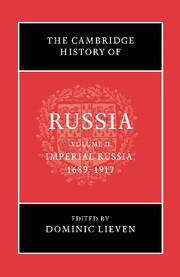Book contents
- Frontmatter
- Introduction
- Part I Empire
- Part II Culture, Ideas, Identities
- Part III Non-Russian Nationalities
- Part IV Russian Society, Law and Economy
- Part V Government
- Part VI Foreign Policy and the Armed Forces
- 23 Peter the Great and the Northern War
- 24 Russian foreign policy, 1725–1815
- 25 The imperial army
- 26 Russian foreign policy: 1815–1917
- 27 The navy in 1900: imperialism, technology and class war
- Part VII Reform, War and Revolution
- Bibliography
- Index
- Map 5. The Russian Empire (1913). From Archie Brown, Michael Kaser, and G. S. Smith (eds.) Cambridge Encyclopedia of Russia 1982.">
- Plate Section">
- References
27 - The navy in 1900: imperialism, technology and class war
from Part VI - Foreign Policy and the Armed Forces
Published online by Cambridge University Press: 28 March 2008
- Frontmatter
- Introduction
- Part I Empire
- Part II Culture, Ideas, Identities
- Part III Non-Russian Nationalities
- Part IV Russian Society, Law and Economy
- Part V Government
- Part VI Foreign Policy and the Armed Forces
- 23 Peter the Great and the Northern War
- 24 Russian foreign policy, 1725–1815
- 25 The imperial army
- 26 Russian foreign policy: 1815–1917
- 27 The navy in 1900: imperialism, technology and class war
- Part VII Reform, War and Revolution
- Bibliography
- Index
- Map 5. The Russian Empire (1913). From Archie Brown, Michael Kaser, and G. S. Smith (eds.) Cambridge Encyclopedia of Russia 1982.">
- Plate Section">
- References
Summary
At the turn of the twentieth century the Russian navy was in a difficult position. Traditionally, its main theatre of operations was the Baltic Sea. Since the first half of the nineteenth century Russia had been the leading naval power among the countries bordering on this sea. Its main enemy had been the British. The Royal Navy could easily block Russian access to the open ocean by patrolling the Sound, in other words the passage between Denmark and Sweden. As was shown in both the Napoleonic and Crimean wars, not only could it also blockade Russian ports and thereby stop Russia’s seaborne trade, it could also mount a realistic threat against Kronstadt and the security of St Petersburg, the imperial capital.
From the early 1880s a new threat emerged on the Baltic Sea as newly united Germany began to build its High Seas Fleet. To some extent this was a worse danger than the British navy had been, since a German fleet enjoying superiority over Russia in the Baltic theatre would be able to operate in conjunction with Europe’s most formidable land forces – in other words the German army. Given the right circumstances, joint operations by the German army and fleet could pose a major threat to the security of Russia’s capital and her Baltic provinces.
Meanwhile the situation in Russia’s second theatre of maritime operations, namely the Black Sea, was also difficult. In the early twentieth century 37 per cent of all Russian exports and the overwhelming majority of her crucially important grain exports went through the Straits at Constantinople.
Keywords
- Type
- Chapter
- Information
- The Cambridge History of Russia , pp. 575 - 590Publisher: Cambridge University PressPrint publication year: 2006
References
- 2
- Cited by

